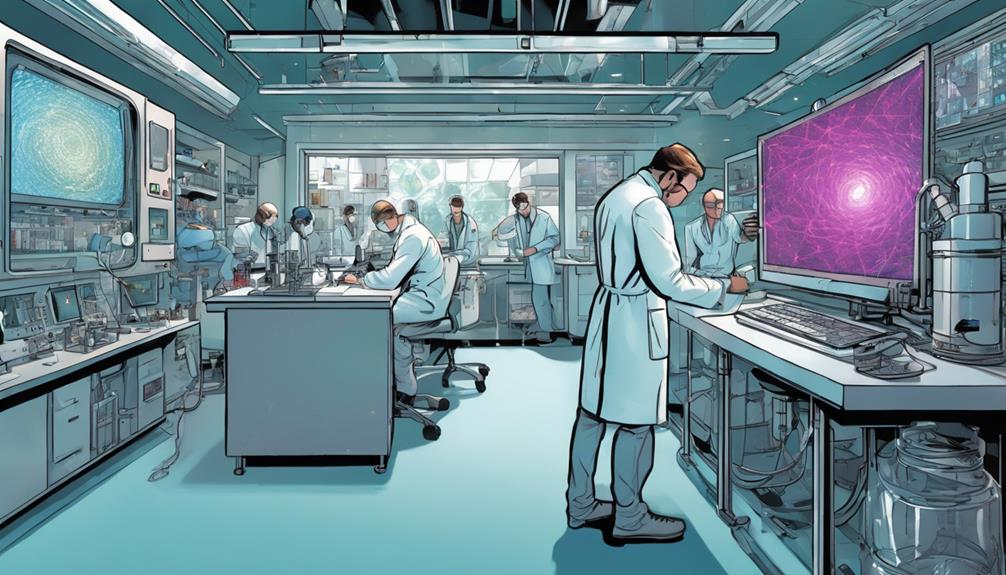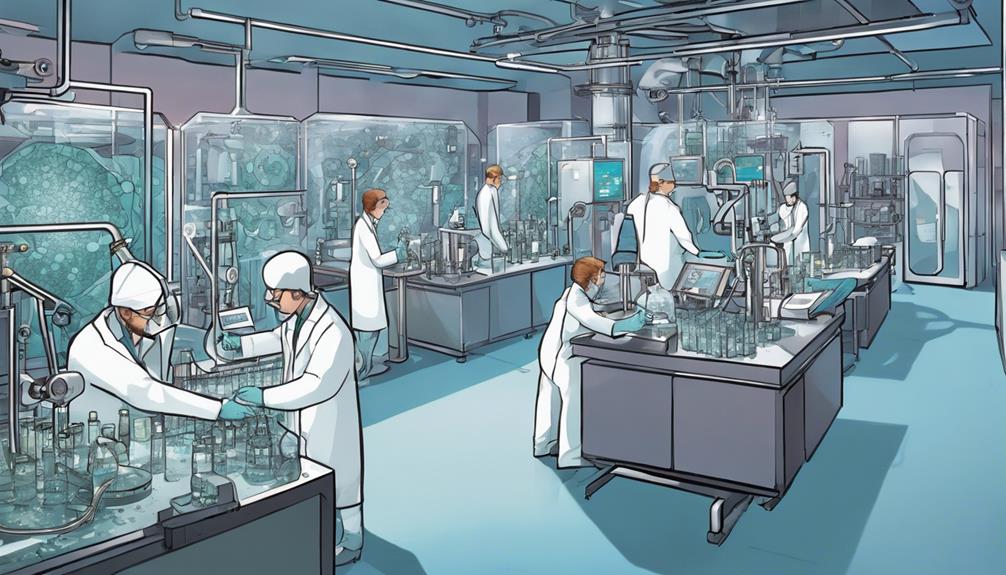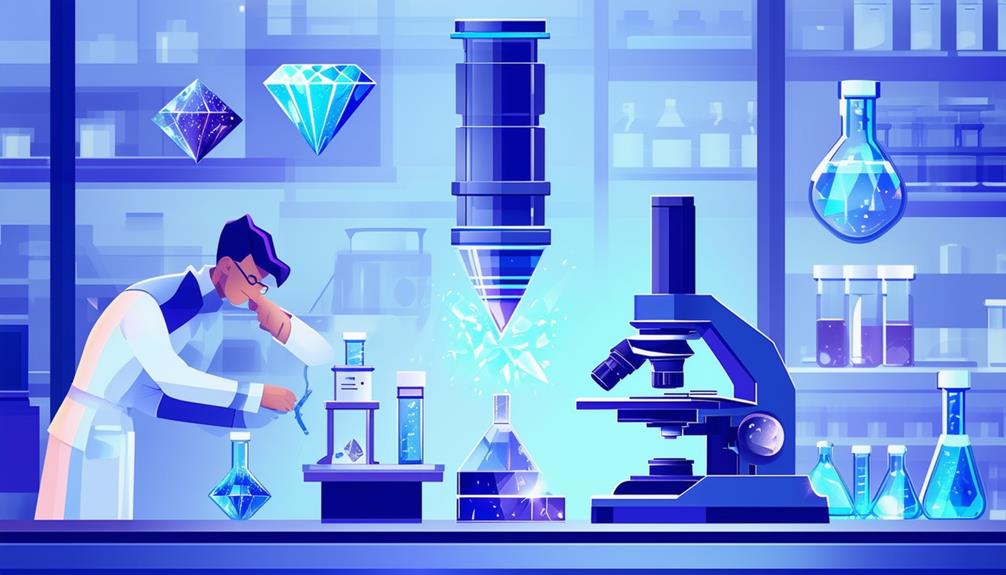Article Contents
The field of lab-grown diamonds is progressing with seven innovative technologies. The High Pressure High Temperature (HPHT) method improves diamond quality through controlled environments.
Chemical Vapor Deposition (CVD) and its variant, Microwave Plasma CVD, focus on sustainable processes and high-quality diamond production.
Ultrasonic Cavitation accelerates crystal formation, while Laser-Assisted technology ensures precise customisation and exceptional diamond quality.
Detonation Synthesis provides a rapid and cost-effective approach. Hybrid Growth Technologies combine the advantages of HPHT and CVD, enhancing overall efficiency.
Each technology contributes uniquely to advancing the art of synthetic diamond manufacturing, paving the way for further developments in this field.
Key Points
- The High Pressure High Temperature (HPHT) method uses specialised presses to exert precise control over the size, colour, and clarity of lab-grown diamonds.
- Chemical Vapor Deposition (CVD) technology produces diamonds by breaking down carbon-rich gases, allowing for improved control over the quality of the diamond.
- The Microwave Plasma Chemical Vapor Deposition (MPCVD) technique uses microwave energy to ensure consistent and high-quality diamond growth.
- Ultrasonic Cavitation technology speeds up diamond formation by using high-frequency sound waves to encourage rapid crystallisation.
- Laser-Assisted Diamond Creation uses powerful lasers to shape diamonds into bespoke designs while maintaining accurate control over their characteristics.
HPHT Diamond Production Method
The High Pressure High Temperature (HPHT) method, developed in the 1950s, is a technique for creating high-quality diamonds by subjecting a carbon source to extreme conditions. This method has evolved to produce diamonds specifically suited for use in jewellery, such as engagement rings. It employs advanced equipment like the belt press and cubic press, which are crucial for applying the necessary pressure and temperature uniformly.
The belt press is integral for producing larger diamonds due to its capability to apply continuous pressure. On the other hand, the cubic press can apply pressure from multiple angles, making it suitable for producing diamonds with enhanced clarity and colour. Each type of press is key in the crystallisation process, which involves a pre-existing diamond seed to ensure that the synthetic diamonds replicate the aesthetic qualities of natural diamonds.
This method allows precise control over the diamond's size, colour, and clarity, appealing to consumers who value customisation and luxury.
CVD Diamond Growth Technology
Chemical Vapour Deposition (CVD) utilises a unique procedure distinct from the High Pressure High Temperature (HPHT) technique, which relies on intense pressures and temperatures. CVD involves placing carbon-rich gases, usually a mixture of methane and hydrogen, into a controlled chamber environment. The gases are then converted into plasma, sparking the deposition of carbon atoms onto a substrate. This incremental layering progresses over several weeks, ultimately resulting in the formation of gem-grade diamonds that are renowned for their exceptional purity and brilliance.
Key aspects of CVD diamond growth technology include:
- Controlled Environment: Maintains optimal conditions necessary for diamond synthesis.
- Carbon Deposition: Involves the steady accumulation of carbon atoms to create the diamond's structure.
- Precision in Quality Control: Facilitates the fine-tuning of variables to improve the clarity and colour of the diamonds.
- Freedom in Diamond Design: Allows for the production of diamonds in diverse shapes and sizes, surpassing the limitations of natural diamond formations.
- Eco-Friendly Approach: Offers a more sustainable and environmentally friendly alternative to traditional diamond mining methods.
CVD technology not only champions innovation and the ability to tailor diamond designs but also promotes sustainability and ethical practices in the diamond industry.
Microwave Plasma CVD Method
Microwave Plasma Chemical Vapor Deposition (MPCVD) utilises microwave energy to effectively stimulate the growth of lab-grown diamonds. This advanced technology harnesses the power of microwave plasma to create optimal conditions for diamond crystal development, ensuring rapid and efficient growth. This method allows manufacturers precise control over the quality of each diamond, maintaining high standards of brilliance and clarity.
The precision afforded by microwave technology in MPCVD is unparalleled. It enables the fine-tuning of various parameters that dictate the diamond's properties, including colour, carat, and clarity. Such meticulous control is crucial for crafting large, high-quality diamonds that closely resemble natural diamonds. Additionally, the consistent delivery of microwave energy throughout the process promotes even diamond growth, essential for superior gem quality.
This consistency is key to producing high-quality diamonds, confirming MPCVD's significance in synthetic diamond production. The capability to monitor and adjust the growth environment closely results in a higher output of premium diamonds, affirming MPCVD's prominence in diamond synthesis.
Ultrasonic Cavitation Diamond Formation
Transitioning from the Microwave Plasma CVD method, the Ultrasonic Cavitation Diamond Formation technique offers a novel approach for diamond synthesis.
This method enhances both the efficiency and yield of diamond production, while ensuring consistent quality ideal for industrial and jewellery applications.
Process Overview
Ultrasonic cavitation diamond formation employs high-frequency sound waves to initiate the nucleation of diamond seeds in a liquid medium. This advanced method enhances the traditional approach to diamond synthesis, aligning with sustainable and ethical gemstone production practices.
- Seed Formation: Utilises high-frequency sound waves to precisely initiate the nucleation of diamond seeds.
- Controlled Environment: Ensures consistent conditions that are optimal for diamond crystal growth.
- High-Quality Diamonds: Yields diamonds with superior clarity and structural integrity.
- Accelerated Growth: The use of sound waves significantly speeds up the growth of diamond crystals.
- Innovative Technique: Marks a significant technological advancement in the field of gemological science, expanding the possibilities in synthetic diamond production.
Efficiency and Yield
Ultrasonic cavitation technology enhances the efficiency and yield of lab-grown diamonds by using cavitation bubbles to promote precise and uniform crystal growth. This method reduces imperfections and ensures the development of high-quality diamonds with exceptional clarity and purity.
The control enabled by this technology not only meets the rigorous standards of quality demanded by consumers but also supports scalable production. Additionally, it aligns with sustainable practices, appealing to eco-conscious individuals.
As this technology continues to advance, it promises to further improve both the production efficiency and the quality of lab-grown diamonds, contributing to the future of sustainable luxury.
Laser-Assisted Diamond Creation

Laser-assisted diamond creation utilises high-intensity lasers to vaporise carbon atoms, which then accurately deposit on a substrate to form high-quality diamond crystals. This advanced method gives exceptional control over the diamond formation process, allowing the production of diamonds in specific shapes tailored to various applications, from jewellery to industrial uses. The process not only meets gem-quality standards but also enhances the efficiency and sustainability of diamond production.
Key benefits of laser-assisted diamond creation include:
- Precision Control: Enables precise control over diamond growth, ensuring each crystal conforms to predetermined specifications for clarity and cut.
- Customisable Shapes: Supports the production of diamonds in a variety of shapes, enhancing creative design options in jewellery and other applications.
- Enhanced Quality: Produces diamonds of superior clarity and colour, comparable to high-quality mined diamonds.
- Faster Production: Speeds up the diamond creation process, meeting high-volume demands more effectively.
- Sustainable Practice: Offers an environmentally friendly alternative to traditional diamond mining, reducing the environmental impact associated with diamond extraction.
Laser-assisted diamond creation represents a significant advancement, combining cutting-edge technology with design flexibility to satisfy both consumer preferences and manufacturing needs.
Detonation Synthesis for Diamonds
Detonation synthesis, transcending traditional laser-assisted methods, uses controlled explosions to create diamonds under high-pressure and high-temperature conditions. This process rapidly transforms carbon-based materials into crystalline diamonds within microseconds, effectively harnessing the intense conditions of detonations. Such a method not only showcases the integration of science and art but also produces diamonds renowned for their exceptional hardness and clarity.
Each diamond generated through detonation synthesis is ensured to be of high purity and quality, making them suitable for both industrial uses and luxury jewellery. The efficiency of this rapid production process makes detonation synthesis a cost-effective approach in the synthetic diamond industry, capable of quickly meeting large demands without the extensive time required by traditional methods.
The diamonds produced possess distinct properties, making them indispensable in fields like electronics and cutting tools where durability and precision are crucial. By offering a reliable supply of high-quality diamonds, detonation synthesis supports wide-ranging applications in various industries, enhancing their functionality and performance. This method not only ensures the production of superior diamonds but also promotes trust and dependability in its application across different sectors.
Hybrid Growth Technologies

Hybrid growth technologies, which combine High Pressure High Temperature (HPHT) and Chemical Vapor Deposition (CVD) methods, greatly improve the production of lab-grown diamonds.
This innovative method not only boosts efficiency but also carefully evaluates the cost implications to ensure economic viability.
Efficiency of Hybrid Methods
Hybrid diamond production technologies combine the benefits of CVD (Chemical Vapour Deposition) and HPHT (High Pressure High Temperature) methods, significantly boosting the efficiency and quality of lab-grown diamonds. These advanced methods optimise the growth environment, allowing for precise control over the diamond's physical and chemical properties, and adaptability to produce diverse types of diamonds.
- Optimised Conditions: Custom environments engineered for optimal diamond synthesis.
- Versatility in Production: Flexible production capabilities to create different diamond varieties.
- Enhanced Quality: Improved control over the diamonds' properties ensures superior quality.
- Advanced Control: Detailed regulation of growth parameters enhances the consistency and reliability of the output.
- Synergistic Effects: The combination of techniques leads to superior outcomes.
Hybrid methods empower producers to craft diamonds that consistently meet high-quality standards, expanding possibilities for both creators and consumers. This approach not only makes the production process more efficient but also improves the quality of the diamonds produced, ensuring trustworthiness and relevance in the market.
Cost Implications Analysis
Hybrid technologies in the production of lab-grown diamonds, which combine the strengths of Chemical Vapor Deposition (CVD) and High Pressure High Temperature (HPHT) methods, require an in-depth analysis of their cost implications to fully grasp their economic impact on the industry.
While these technologies involve a significant initial investment, they may reduce operational costs over time, striking a balance between high quality and cost efficiency.
Conducting such an evaluation is crucial for producers seeking to optimise their manufacturing processes while ensuring financial viability.
This analysis not only aids in strategic decision-making but also influences the competitive landscape of the lab-grown diamond industry, promoting innovation while maintaining financial health.
Frequently Asked Questions
What Technology Is Used to Make Lab-Grown Diamonds?
Lab-grown diamonds are produced using two main methods: Chemical Vapor Deposition (CVD) and High Pressure High Temperature (HPHT). These techniques include advanced seeding processes that aim to minimise environmental impacts, providing a more ethical option in the jewellery industry.
What Equipment Is Used to Make Lab-Grown Diamonds?
Lab-grown diamonds are created using advanced equipment like diamond presses, High Pressure High Temperature (HPHT) machines, Chemical Vapor Deposition (CVD) systems, Microwave Plasma Chemical Vapor Deposition (MPCVD) equipment, ultrasonic cavitation-based systems, and laser-assisted machines. These technologies guarantee accurate control over environmental conditions that are essential for diamond production.
Which Lab-Grown Diamond Process Is Better?
Determining which lab-grown diamond process is superior requires an analysis of several factors, including environmental sustainability, energy consumption, and the quality of the diamonds produced. The High Pressure High Temperature (HPHT) method tends to produce high-quality diamonds. However, the Chemical Vapor Deposition (CVD) process is generally less energy-intensive and more aligned with current market preferences for sustainable and cost-effective solutions. Thus, the choice between HPHT and CVD depends on specific priorities such as environmental impact versus quality of the final product.
Is HPHT or CVD better?
When assessing the scalability of production and market acceptance, HPHT diamonds are frequently favoured. They are prized for their excellent quality and do not need any further treatments post-growth, making them a popular option for luxury jewellery and engagement rings.
Summary
In conclusion, the range of technologies for creating lab-grown diamonds represents a major step forward in sustainable luxury. Methods such as HPHT and innovative hybrid approaches show a dedication to quality, providing diamonds that match natural ones in sparkle while reducing environmental harm.
This blending of technology and artistic flair in diamond manufacturing showcases human ingenuity, suggesting a future where opulent diamonds are sustainable for the environment.

